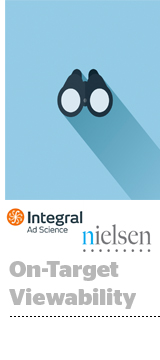 Beyond knowing whether an ad was viewed and for how long, marketers want to verify viewability percentages against key audience segments, which is the basis of a new alliance between Nielsen and Integral Ad Science (IAS).
Beyond knowing whether an ad was viewed and for how long, marketers want to verify viewability percentages against key audience segments, which is the basis of a new alliance between Nielsen and Integral Ad Science (IAS).
Although the two companies have partnered since 2012, they have now expanded the scope of their relationship to offer demographic-based viewability measurement for Nielsen Digital Ad Ratings in the US, Canada, Brazil, France, Germany, Australia, the UK and Italy.
The partnership allows a more nuanced look at the percentage of a target audience reached – and how different segments respond to ads across sites and platforms.
The deal only touches desktop display for now, but Megan Clarken, EVP of global watch product leadership at Nielsen, said it will include video by the end of the year with mobile to follow.
“The integration we’ve done here enables single tag implementation with always-on viewability metrics layered on top of audience metrics,” she told AdExchanger. “Clients can slice and dice it so they can view viewability by demo and compare viewability by platform to see which performed better than others with desired audiences.”
The single-tag solution will help reduce latency, both for the publisher and the ad buyer. Page load times suffer if, for instance, a tag set forth by a buying platform takes too long to talk to a tag embedded at the site level. In this case, a single tag reduces that friction.
“Having a unified tag was absolutely a driver for the design of the solution,” noted Scott Knoll, CEO of Integral Ad Science. “Since you’re dealing with one tag instead of two, it’s easier to manage and lighter in the browser than two separate tags.”
Tag unification was also a driver with Nielsen’s earlier partnership with Adobe for Nielsen’s Digital Content Ratings cross-platform metric.
Clarken said using the Adobe tags and architecture in that instance allowed it to pull cross-platform measurement into Nielsen’s system and reduce the friction that would have otherwise existed if Adobe and Nielsen went about things separately.
“This is why you see us forming relationships with Integral Ad Science and others,” she said. “By forming these alliances and partnerships, you make this as friction-free as possible for the content owners.”
Nielsen’s expanded partnership with IAS comes just days after Facebook revealed it would open up third-party viewability verification on its platform through independent provider Moat.
AdExchanger Daily
Get our editors’ roundup delivered to your inbox every weekday.
Daily Roundup
Clarken doesn’t view individual seller/verification vendor alliances as counterproductive to Nielsen’s efforts.
“The marketplace is still establishing rules between buyers and sellers around what constitutes a viewable impression,” she said. “Media owners and brands have their own perspective, and we don’t know where that will settle. But we ultimately want to take the rules established by the marketplace and embed them in our system” while strictly adhering to the Media Rating Council’s provisions.
Regardless of agreed upon rules, Clarken noted the many challenges that remain around establishing viewability parameters for certain formats, particularly mobile video.
Put simply, integrating measurement with mobile ad tech is hard, she said.
“At the moment, even the best players out there have to build out SDKs that are very complex and cumbersome,” she said. “Putting software into an environment where the screen is constantly moving between browser and apps with different video formats rendering is difficult.”













